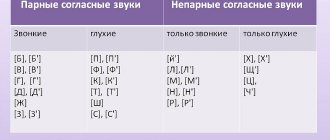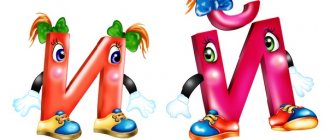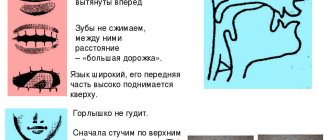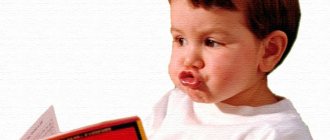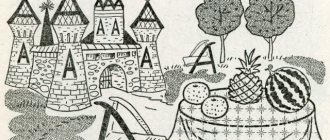Online speech therapy exercises
Speech therapy of vowels:
|
| | | | | | | | | Difficult vowels:
e;e;yu;ya |
e;u;e;y;a;o;e;ya;i;yu | Setting consonant sounds and letters:
|
| | | | | | | | | | | | | | | | | | | Difficult consonants:
b;p | w;w | z;s | g;k | s;ts | v;f | r;l | p;l | r;p;l | z;s;c | h;f;sh;sch;ts;x |
You can use all the speech therapy material provided on the site as a speech therapy aid! Speak words clearly pronouncing letters and syllables. Classes with a specialist and computer programs will help the child improve memory and attention. Articles and exercises from the site () will help you understand whether your child speaks correctly.
Setting the sound Ch
Goal: to teach the child to pronounce the standardized sound h .
Equipment: diagram of the structure of the articulatory apparatus when pronouncing the sound h; probe, spatula; pictures-symbols, subject pictures.
Staging sound in various ways.
1. By imitation:
- the child is offered a sample of sound pronunciation in combination with play images (the chirping of a grasshopper, etc.); At the same time, visual control of correct articulation and tactile (tactile) sensations are used.
2. From the merger of the constituent parts of the affricate h:
— the child is asked to pronounce the sounds t', sch as he exhales: first slowly, then quickly and sharply (in unison).
3. From reference sound:
- the child is asked to pronounce the syllable, paying attention to the connection of the tongue with the alveoli, gradually moving the tongue back; You can additionally imitate the movement of the tongue with your hands.
4. From reference sound with mechanical assistance:
— the child is asked to pronounce the sound/syllable th/at, paying attention to the connection of the tongue with the alveoli, gradually moving the tongue back with a spatula placed over the tongue;
- the child is asked to pronounce the sound, at the same time lightly press his fingers on the corners of his mouth and stretch his lips forward - “with a mouthpiece”: the tip of the tongue moves back, the sound h is heard.
Correction of violations of the pronunciation of the sound /Ch/
The child is asked to raise the tip of the tongue to the “tubercles” behind the upper teeth and pronounce the combination “at.” At the same time, the speech therapist, pressing his fingers on the corners of the child’s lips, pushes them forward. It turns out “ach”.
One hundred thousand why
Close
Pronouncing the sound “Ch” often causes difficulties for children. To teach a child to pronounce it, you need to go through several stages.
Preparatory work
Work on any sound should begin with articulatory gymnastics. This will allow you to warm up and get ready for work. For warming up, you can choose any gaming technique. Let's consider just a few options.
1. “Swing”: this exercise helps strengthen the muscles of the tongue and teach the child to control the tip of the tongue. The mouth is open, the lips are in a smile. The child alternately touches the top and bottom of the mouth with his tongue, then the upper and lower teeth, the place behind the upper and lower teeth.
2. “The tongue walks through the teeth” The mouth is open, the lips are in a smile. The child touches the outer and inner surfaces of the upper and lower teeth with his tongue.
You can also ask your child to clap his hands when he hears the sound “Ch.” Then you should first pronounce simply different sounds, then syllables and words. This technique will allow you to evaluate how well the baby recognizes the desired sound. If a child has better developed visual thinking, instead of words, offer him pictures with “H” in the name.
Breathing exercises
Setting the sound "Ch"
The sound “CH” consists of the sounds “Ш” and “Ть”. This means that a child who correctly pronounces the last two sounds will easily cope with pronouncing “Ch”. There are two ways to produce this sound.
1. The child must very quickly pronounce the combination of sounds “TH” and “SH”. It is very important that the lips are in a wide smile. 2. The child pronounces the sound “TH” very quickly, repeating it. First, the tongue should touch the base of the teeth from the inside, then you should gradually move it a little deeper, towards the alveoli. If you can’t learn to pronounce “Ch”, you can contact a speech therapist who will make the sound using a special probe.
To make sure that the sound is delivered, you should check how the child pronounces it in isolation. Game techniques are also used for this: the baby can be asked to imitate the passage of a clock using the sound “Ch” or to calm someone down (“Ch-Ch-Ch”). If everything is in order, you can start automation.
Automation of the sound "Ch"
Automation should be carried out taking into account the age of the child. With a baby, it is best to use pictures or toys; with older children, rhymes and songs are perfect. You should start by pronouncing syllables, and then gradually move on to words and sentences. In this case, you need to select such material so that the sound “Ch” appears in different positions. In any case, automation should take place in a playful way. There are a variety of games you can use.
1. “Songs with your favorite character.” It is necessary to choose any fairy-tale or cartoon character that is interesting to the child, and write on the cards the syllables containing the letter “H”. Then you need to offer the following task: “Your favorite hero decided to help you learn to pronounce “Ch” and prepared songs for you from the syllables. Sing along with him! Cha-cha-cha; Cho-cho-cho; Chu-chu-chu; Chi-chi-chi." It is very important that the child pronounces the “Ch” sound in a syllable correctly; only in this case can one move on to the next syllable. 2. "Echo". The child must repeat several words spoken by an adult in the same order, emphasizing the “Ch” sound. 3. "Offer". For this exercise, you can write a few words with the letter “C” on paper or use pictures. The child’s task is to make a sentence with each of them. 4. "Cubs" It should be suggested to name the cubs of various animals and birds (squirrels, hares, jackdaws, wolves), emphasizing the sound “Ch”. 5. "Confusion." The child is offered sets of letters from one word in a mixed order. His task is to collect the word and pronounce it.
Staging and automation of the sound “Ш”
Share on social media networks
I like
Related posts:
Staging and automation of sound [H]
Staging and automation of sound [CH].
Affricate, continuous (T, Sh: T - not lingual-dental, but lingual-alveolar; Ш - upper), voiceless, oral, occlusive-frictional.
Articulation is normal when spoken in isolation.
The lips are slightly pushed forward. The distance between the incisors (teeth) are compressed or brought closer together (2 - 3) mm. At the first moment, the tip of the tongue is pressed to the alveoli - a bow. At the second moment, the bow opens with an explosion and moves to the “upper” position. The lateral edges are pressed against the upper molars, the back and root are lowered. The entire tongue is shaped like a cup. The soft palate is raised and closes the passage to the nose. Vocal cords are open. You can see the position of the lips, that the tip of the tongue is at the top and the position of the lateral edges. You can feel the absence of vibration and the air flow as with C.
Staging. Hearing - visual analysis before sound, repeated repetition (Sh must be without defects). Tactile - vibration sensations. AS - AC (the tip of the tongue is not at the upper incisors, but at the alveoli - we move it further). We rely on the nature of the air stream. Mechanical way. On the C base, using a probe, spatula, finger. C must be free of defects. You place a spatula under the tip of your tongue: “Say C—the lips are not labialized, but when C—they are labialized. Don't rush to give the letter. Only when it is possible to remove the spatula.
Types of incorrect pronunciation. “Dental sigmatism” Ch=C. The tip of the tongue opens and falls down, not remaining in position with the sound “Sh”. Auditory - visual + tactile - vibration sensations with the sound Sh. Replacing Ch with Sh. The tip of the tongue does not form a connection with the alveoli, there is no jerky jet, only a solid one. This phoneme is acceptable according to the abbreviated system of phonemes, only before the sound “CH” is added. “Whistling sigmatism” Ch = C. The tip of the tongue is at the bottom, the back does the jerking work. Reinstall, but not on the basis of C. “Lateral sigmatism”. Cheeks swell, saliva splashes, side edges work; the tip of the tongue forms a bridge either with the alveoli or with the lower incisors, or closes the gap between the incisors. We set the sound again.
Automation of sound [H] . Correctly pronounce the sound [H] in syllables. CHA, CHO, CHU, CHI, CHE, CHA-CHO, CHA-CHO, CHA-CHI, CHA-CHE, CHO-CHA, CHO-CHO, CHO-CHI, CHO-CHE, CHO-CHA, CHU-CHO, CHOO-CHEE, CHOO-CHEE. We highlight the stressed syllables CHA CHA, CHA CHACHA, CHA CHA , CHA CHA CHA, CHACH CHA. We pronounce the sound CH in the words HOUR, MIRACLE, MONSTER, CAST IRON, PURITY, MAN, TOWET, STOCKING. We automate the sound [CH] between the vowel sounds ACHA, OCHO, UCHU, YCHI, ACHO, UCHA, OCHA, OCHU, ACHU. We pronounce the sound Ch in words. ROCKING CAIR, WASTE SHARPENER, SWING, COACH. Correctly pronounce the sound CH in combination with the consonant CHVO, CHVA, CHLO, CHMO, CHNO, CHRO, CHVA, CHLA, CHMA, CHNA, CHRA, CHWU, CHLU, CHMU, CHNU. We pronounce the sound Ch in words. DAUGHTER, BUMMET, POINT, NIGHT CLOUND. We pronounce the sound CH in the reverse syllable ACH, OC, UCH YCH. We pronounce the sound CH in words. DAUGHTER, NIGHT, ROOK, ROLLER, HOOP, BALL. We pronounce the sound [H] in sentences. ON THE ROOK TREE, MOTHER HAS A DAUGHTER, NIGHT HAS CAME.
The sound "ch" is a voiceless consonant
To understand whether the consonant “ch” is voiced or voiceless, let’s observe its pronunciation.
When it is formed, the lips move forward a little and are slightly rounded. The tip of the tongue touches the palate. The lateral edges of the tongue are pressed tightly against the upper molars. The back of the tongue rises. As exhaled air passes, the tip of the tongue breaks away from the palate. This produces a characteristic noise.
The voice does not participate at all in the formation of the sound [h']. This can be understood if you place your palm on the front wall of your throat. You will not feel vibrations or vibrations of the vocal cords. The throat does not tremble. The vocal cords are resting.
Conclusion
This means that the sound [ch'] is a noisy voiceless consonant in the Russian language.
Its phonetic feature is the absence of a paired voiced consonant, unlike other consonants that have a phonetic pair based on voicedness/voicelessness:
- [b] - [p]: bot - sweat;
- [v] - [f]: enemy - tailcoat;
- [g] - [k]: slide - crust;
- [d] - [t]: house - vol.
Hissing sounds: where to start staging
We show the child a card with the sound Ш, draw a phoneme, explain how the tongue is located: now it is at the top, the edges are pressed tightly against the molars. Instead of the phrase “sound Ш” it is better to say “warm wind”, “snake hisses”, “inflate the balloon”.
Articulatory gymnastics for staging hissing (exercises by L.A. Komarova)
- “Cup”
- the mouth is open. Raise a wide, relaxed tongue to the upper lip. Bend the middle part of the tongue and bend the side edges upward. It turns out to be a cup. We take the “cup” inside and take it back out. Do this several times. - “Horse”
- “glue” the tongue to the palate. Thus, the hyoid frenulum is stretched. The lower jaw remains motionless. With a click, we “unstick” the tongue - the “horse” clicks. - “Fungus”
- “glue” the tongue to the palate, open the mouth wide. Hold this position for several seconds. - “Accordion”
- make a “mushroom”. Only now we open and close our mouth, stretching the hyoid frenulum. Keep your tongue “glued” to the palate, lips in a smile. - “Swing”
- mouth wide open. Stretch your tongue either to your nose or to your chin. - “Donut”
– mouth slightly open, lips extended slightly forward and rounded.
“Let’s warm our palms” - imagine that your hands are frozen in the cold. Open your mouth, stretch your lips forward, exhale “x-x-x”, warming your palms.
The exercises that are performed when setting C, “Punish a naughty tongue”, “Spatula”, “Candy”, “Jam”, “Brushing teeth” are repeated when setting Sh. You don’t need to do everything, choose 5-7 of any articulation exercises, and also remember about the development of the air stream.
Ways to make the sound Ш
In front of the mirror, we ask the baby to blow a cold wind onto his palm. Now invite the child to “cup” his tongue by the upper teeth onto the alveoli and try to say “ssss” again. In this position of the tongue you will hear “sh-sh-sh”. If it doesn’t work out, you can hold the roll stick between your teeth (your tongue should lie on the stick, not under it) and blow. Or use a clean finger to hold your tongue up. It is important to explain to the baby that the wide tongue should be behind the upper teeth - then “the snake will hiss.”
After successful consolidation of Ш, we obtain the sound Ж in the same way as the phoneme Z. We place our palm on the throat and ask the child to compare hissing and buzzing: “sh-sh-sh” - the throat is calm, “zh-zh” - the throat is trembling.
To get H, ask your baby to say a soft "t'-t'-t'" and gently move his tongue slightly deeper into the mouth using a spoon/q-tip/clean finger. The sound SH should appear automatically. We fix each phoneme according to the scheme, teach the child not to confuse whistling and hissing. For this purpose, learning poems where both types of sounds are found, and games for differentiating phonemes are suitable.
10 books for automating sounds
- “Speech therapist lessons. Correction of speech disorders”, N.S. Zhukova.
- “Album of a preschooler. Automation of sounds in game exercises”, L.A. Komarova.
- “We learn sounds. Home speech therapy notebook for children 5-7 years old,” E.A. Azova, O.O. Chernova.
- “We pronounce the sounds correctly. Speech therapy album for children 4-8 years old,” T.A. Tkachenko.
- “Home notebook for speech therapy sessions with children”, Yu.B. Zhikhareva-Norkina.
- “Games with paired cards. Speech therapy board games for children 5-7 years old”, Z.T. Bobyleva.
- “I speak correctly”, didactic material by O.E. Thunderous.
- “We are speaking correctly. Games for speech development”, E.M. Kuritsyna, L.A. Taraeva.
- “Album for automating sound pronunciation”, O.I. Lazarenko.
- “Speech therapy album. We speak correctly,” T.S. Reznichenko, O.D. Larina

